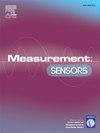Two-step compensation via rotational stepping error fitting for precise azimuth measurement with electronic compass
Q4 Engineering
引用次数: 0
Abstract
Marine buoys commonly employ electronic compasses to measure their azimuth angles under the requirements for low power consumption and high precision. After installation on buoys, geomagnetic electronic compasses often suffer from measurement errors in azimuth angles due to manufacturing errors and magnetic interference from the buoy structure. This paper presents a two-step compensation method for azimuth measurement errors of electronic compass based on rotational step error fitting. In the first step, before installation on the buoy, the magnetometer of the electronic compass is calibrated using the ellipsoidal fitting method, which requires arbitrary rotation of the lightweight compass around multiple different axes. In the second step, after mounting the electronic compass inside the buoy, stepwise rotations are performed to collect azimuth measurement errors at various angles. The least squares method is then applied to fit the developed error function relative to rotation angle to generate compensation values for various azimuths, which are used for secondary error compensation. Experimental results demonstrate that using azimuth angles calculated by high-precision satellite positioning devices as absolute reference values, the measurement accuracy of azimuth angles reaches 0.6° after applying the proposed compensation method to the electronic compass. This approach avoids the use of three-dimensional rotation operations or large Helmholtz coils and is therefore simple and suitable for field operation.
旋转步进误差拟合两步补偿,用于电子罗经精确方位测量
在低功耗、高精度的要求下,船用浮标的方位角测量一般采用电子圆规。地磁电子罗盘安装在浮标上后,由于制造误差和浮标结构的磁干扰,往往会产生方位角测量误差。提出了一种基于旋转步长误差拟合的电子罗经方位测量误差两步补偿方法。第一步,在安装到浮标上之前,使用椭球拟合方法对电子罗盘的磁力计进行校准,这需要围绕多个不同的轴任意旋转轻质罗盘。第二步,将电子罗经安装在浮标内,进行逐级旋转,收集不同角度的方位测量误差。然后利用最小二乘法对得到的误差函数相对于旋转角度进行拟合,得到不同方位角的补偿值,用于二次误差补偿。实验结果表明,以高精度卫星定位装置计算的方位角为绝对参考值,将所提出的方位角补偿方法应用于电子罗盘后,方位角测量精度达到0.6°。这种方法避免了使用三维旋转操作或大型亥姆霍兹线圈,因此简单,适合现场操作。
本文章由计算机程序翻译,如有差异,请以英文原文为准。
求助全文
约1分钟内获得全文
求助全文
来源期刊

Measurement Sensors
Engineering-Industrial and Manufacturing Engineering
CiteScore
3.10
自引率
0.00%
发文量
184
审稿时长
56 days
 求助内容:
求助内容: 应助结果提醒方式:
应助结果提醒方式:


